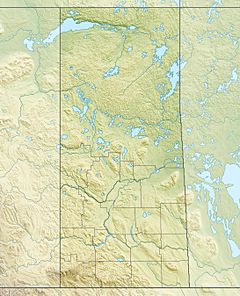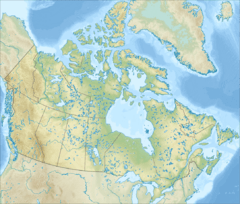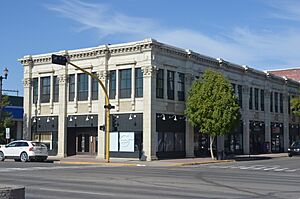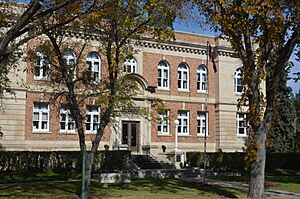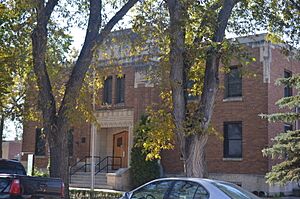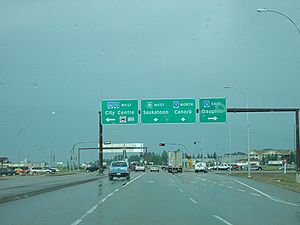Yorkton facts for kids
Quick facts for kids
Yorkton
|
|||
|---|---|---|---|
|
City
|
|||
| City of Yorkton | |||
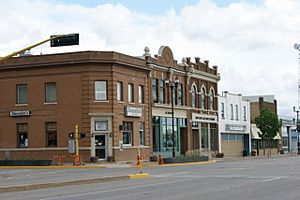
Downtown on Broadway Street
|
|||
|
|||
| Motto(s):
"Where Good Things Happen"
|
|||
| Country | Canada | ||
| Province | Saskatchewan | ||
| Incorporated village | July 15, 1894 | ||
| Incorporated town | 1900 | ||
| Incorporated city | February 1, 1928 | ||
| Government | |||
| • Type | Mayor and Council | ||
| Area | |||
| • City | 25.77 km2 (9.95 sq mi) | ||
| Elevation | 500 m (1,600 ft) | ||
| Population
(2021)
|
|||
| • City | 16,280 | ||
| • Density | 449.8/km2 (1,165/sq mi) | ||
| • Metro | 18,905 | ||
| • Metro density | 22.4/km2 (58/sq mi) | ||
| Time zone | UTC−6 (CST) | ||
| • Summer (DST) | UTC−6 (CST) | ||
| Forward sortation area |
S3N
|
||
| Area code(s) | 306 / 639 | ||
| Highways | |||
| Post office established | January 1, 1884 | ||
| Website | City of Yorkton | ||
Yorkton is a city in southeastern Saskatchewan, Canada. It's about 450 kilometers (280 miles) northwest of Winnipeg and 300 kilometers (186 miles) southeast of Saskatoon. Yorkton is the sixth largest city in Saskatchewan.
The city was started in 1882 and became an official city in 1928. It is surrounded by the rural areas of Orkney and Wallace.
Contents
History of Yorkton
In 1882, a group of business people created the York Farmers Colonization Company. They wanted to find good land for a new settlement. They found a promising area near the Little Whitesand River (now called Yorkton Creek).
This group bought land to create a new community and a trading center. This new place was named York Colony. The company gave free land lots to settlers who bought land from them. The original colony stayed by the river until 1889.
In 1889, a railway line was built near Yorkton. Because of this, the town moved closer to the new railway, which made it easier for people and goods to travel.
Geography and Climate
Yorkton is located in an area called the aspen parkland ecosystem. This means you'll see a mix of open grasslands and small groups of aspen trees. The land is mostly used for farming, and there aren't many forests.
The soil in this area is very rich and dark, which is great for growing crops. The land was shaped by glaciers a long time ago, leaving behind a flat plain with glacial deposits.
Yorkton's Climate
Yorkton has a humid continental climate. This means it has big differences between summer and winter temperatures. Summers are warm, and winters are very cold.
- The average temperature in January is about -17.9°C (0°F).
- The average temperature in July is about 17.8°C (64°F).
The hottest temperature ever recorded in Yorkton was 40.6°C (105°F) on July 19, 1941. The coldest temperature ever recorded was -46.1°C (-51°F) on January 20, 1943.
| Climate data for Yorkton Municipal Airport, 1981–2010 normals, extremes 1884–present | |||||||||||||
|---|---|---|---|---|---|---|---|---|---|---|---|---|---|
| Month | Jan | Feb | Mar | Apr | May | Jun | Jul | Aug | Sep | Oct | Nov | Dec | Year |
| Record high humidex | 6.7 | 10.4 | 21.1 | 29.9 | 37.5 | 42.7 | 43.4 | 44.7 | 37.3 | 30.2 | 20.0 | 12.4 | 44.7 |
| Record high °C (°F) | 8.3 (46.9) |
11.0 (51.8) |
21.1 (70.0) |
31.7 (89.1) |
38.4 (101.1) |
38.3 (100.9) |
40.6 (105.1) |
38.3 (100.9) |
36.1 (97.0) |
31.1 (88.0) |
20.6 (69.1) |
12.7 (54.9) |
40.6 (105.1) |
| Mean daily maximum °C (°F) | −11.4 (11.5) |
−7.6 (18.3) |
−1.5 (29.3) |
9.3 (48.7) |
17.3 (63.1) |
21.7 (71.1) |
24.3 (75.7) |
23.9 (75.0) |
17.5 (63.5) |
9.5 (49.1) |
−1.7 (28.9) |
−6.1 (21.0) |
7.7 (45.9) |
| Daily mean °C (°F) | −16.7 (1.9) |
−12.8 (9.0) |
−6.7 (19.9) |
3.2 (37.8) |
10.4 (50.7) |
15.5 (59.9) |
17.9 (64.2) |
17.1 (62.8) |
11.1 (52.0) |
3.7 (38.7) |
−6.3 (20.7) |
−14.1 (6.6) |
1.9 (35.4) |
| Mean daily minimum °C (°F) | −22.0 (−7.6) |
−18.0 (−0.4) |
−11.9 (10.6) |
−2.9 (26.8) |
3.5 (38.3) |
9.2 (48.6) |
11.5 (52.7) |
10.2 (50.4) |
4.7 (40.5) |
−2.2 (28.0) |
−10.9 (12.4) |
−19.0 (−2.2) |
−4.0 (24.8) |
| Record low °C (°F) | −46.1 (−51.0) |
−45.6 (−50.1) |
−42.8 (−45.0) |
−27.2 (−17.0) |
−13.5 (7.7) |
−5.0 (23.0) |
−1.1 (30.0) |
−2.8 (27.0) |
−12.8 (9.0) |
−28.3 (−18.9) |
−37.5 (−35.5) |
−42.2 (−44.0) |
−46.1 (−51.0) |
| Record low wind chill | −58.4 | −58.0 | −52.0 | −40.0 | −16.5 | −4.9 | 0.0 | −5.7 | −12.9 | −29.6 | −45.8 | −55.6 | −58.4 |
| Average precipitation mm (inches) | 16 (0.6) |
11.2 (0.44) |
20 (0.8) |
21.6 (0.85) |
51.3 (2.02) |
80.1 (3.15) |
78.2 (3.08) |
62.2 (2.45) |
44.9 (1.77) |
26.5 (1.04) |
16.4 (0.65) |
21 (0.8) |
449.3 (17.69) |
| Average rainfall mm (inches) | 0.2 (0.01) |
0.4 (0.02) |
3.6 (0.14) |
11.7 (0.46) |
48.3 (1.90) |
79.9 (3.15) |
78.2 (3.08) |
62.2 (2.45) |
43.5 (1.71) |
19.2 (0.76) |
2.1 (0.08) |
0.5 (0.02) |
349.6 (13.76) |
| Average snowfall cm (inches) | 20 (7.9) |
12.7 (5.0) |
18.1 (7.1) |
11.1 (4.4) |
3.4 (1.3) |
0.2 (0.1) |
0 (0) |
0 (0) |
1.4 (0.6) |
8.5 (3.3) |
17.2 (6.8) |
24.8 (9.8) |
117.4 (46.2) |
| Average precipitation days (≥ 0.2 mm) | 11.36 | 8.62 | 9.91 | 9.54 | 15.64 | 20.96 | 19.05 | 16.3 | 13.48 | 10.43 | 9.23 | 12.11 | 157.4 |
| Average rainy days (≥ 0.2 mm) | 0.36 | 0.72 | 2.37 | 5.68 | 14.84 | 20.96 | 19.05 | 16.3 | 12.88 | 7.39 | 1.92 | 0.79 | 103 |
| Average snowy days (≥ 0.2 cm) | 12 | 8 | 7 | 3 | 1 | 0 | 0 | 0 | 1 | 4 | 9 | 11 | 58 |
| Average relative humidity (%) | 70.3 | 69.8 | 66.1 | 50.4 | 43.8 | 50.3 | 52.5 | 49.6 | 50 | 54.7 | 69.1 | 72.3 | 58.2 |
| Mean monthly sunshine hours | 104.2 | 131.9 | 174.1 | 230.0 | 268.0 | 268.1 | 315.0 | 285.8 | 195.7 | 155.0 | 99.9 | 88.6 | 2,316.3 |
| Percent possible sunshine | 39.9 | 46.8 | 47.4 | 55.5 | 55.6 | 54.2 | 63.2 | 63.2 | 51.4 | 46.6 | 37.2 | 35.9 | 35.9 |
| Source: Environment Canada | |||||||||||||
Extreme Weather Events
Yorkton has experienced some big storms:
- On July 1, 2010, a severe thunderstorm hit Yorkton. It brought hail, strong winds, lightning, and heavy rain. This caused a flash flood that badly damaged local businesses. The city declared a State of Emergency.
- On June 29, 2014, another flash flood happened after heavy rain. Again, the city declared a State of Emergency.
Population and People
| Historical populations | ||
|---|---|---|
| Year | Pop. | ±% |
| 1901 | 700 | — |
| 1911 | 2,309 | +229.9% |
| 1921 | 5,151 | +123.1% |
| 1931 | 5,027 | −2.4% |
| 1941 | 5,586 | +11.1% |
| 1951 | 7,074 | +26.6% |
| 1961 | 9,995 | +41.3% |
| 1971 | 13,430 | +34.4% |
| 1981 | 15,339 | +14.2% |
| 1991 | 15,315 | −0.2% |
| 2001 | 15,107 | −1.4% |
| 2006 | 15,038 | −0.5% |
| 2011 | 15,669 | +4.2% |
| 2016 | 16,343 | +4.3% |
| 2021 | 16,280 | −0.4% |
| Source: Statistics Canada | ||
In 2021, Yorkton had a population of 16,280 people. This was a small decrease from its 2016 population of 16,343. The city has a land area of about 36.19 square kilometers (13.97 square miles).
Who Lives in Yorkton?
The first settlers in Yorkton were English people from Eastern Ontario and Great Britain. About 6 kilometers (3.7 miles) west, Scottish settlers created a community called Orkney. Many people in Yorkton today are also descendants of immigrants from Ukraine who arrived in the early 1900s.
Yorkton is a diverse city with people from many different backgrounds. Here are some of the main ethnic groups in Yorkton as of 2021:
| Major ethnic groups in Yorkton, Saskatchewan, 2021 | ||
|---|---|---|
| Ethnic group | Population | Percent |
| Ukrainian | 4,805 | 30.2% |
| English | 3,870 | 24.3% |
| German | 3,540 | 22.2% |
| Scottish | 2,185 | 13.7% |
| First Nations/Métis | 2,055 | 13.7% |
| Irish | 1,610 | 10.1% |
| Polish | 1,405 | 8.8% |
| Scandinavian | 1,350 | 8.5% |
| French | 1,060 | 6.7% |
| Filipino | 1,030 | 6.5% |
| Total respondent population | 15,925 | 100% |
Fun Things to Do in Yorkton
The Yorkton Gallagher Centre is a large place for events and fun. It was built in 1977. It has an arena for sports, a curling rink, meeting rooms, and an indoor swimming pool.
Yorkton is also home to a branch of the Saskatchewan Western Development Museum. This museum shows what pioneer life was like in the town and on the prairie. You can see an old log home and many old farming machines, like early tractors and steam engines.
If you walk around downtown Yorkton, you'll see cool murals on several buildings. These murals show important people and events from the city's past.
Historic Places to See
There are many old and important buildings in Yorkton. Some of these include:
- Yorkton Tower Theatre: A movie theater built in the 1950s.
- Hudson's Bay Company Store: An old store building.
- St. Paul's Lutheran Church.
- Yorkton Armoury: A building used by the military.
- Yorkton Court House: The city's courthouse.
- The Old Land Titles Building.
Yorkton Film Festival
The Yorkton Film Festival is a long-standing event in the city. It started in 1947 as an international documentary film festival. Later, it changed to focus on Canadian short films. Since 2009, it has been known as the Yorkton Film Festival.
Sports in Yorkton
Yorkton has hosted some big sports events:
- The 1999 Royal Bank Cup (a national championship for Junior "A" ice hockey teams).
- The 2006 World Junior A Challenge (an international hockey tournament).
- The 2009 Canada Cup of Curling.
Local Sports Teams
- The Yorkton Terriers are a hockey team that plays in the Saskatchewan Junior Hockey League.
- The Yorkton Rawtec Maulers are a Midget AAA ice hockey team.
- Both teams play their games at the Westland Arena in the Yorkton Gallagher Centre, which can hold 2,300 people.
- The Yorkton Cardinals were a baseball team that played in the Western Canadian Baseball League.
- The Yorkton Bulldogs were a box lacrosse team formed in 2003.
City Services and Transportation
Getting Around Yorkton
Yorkton has several ways to get around:
Air Travel
The Yorkton Municipal Airport (YQV/CYQV) is located north of the city. It was built during World War II for the Royal Canadian Air Force to train pilots.
Roads
Yorkton is located where several major highways meet: Highway 52, Highway 10, Highway 9, and The Yellowhead Highway. The Yellowhead Highway is part of the Trans Canada Highway.
Trains
Both the Canadian National Railway and the Canadian Pacific Railway have lines that serve Yorkton, helping to move goods in and out of the city.
Public Transit
Yorkton Transit runs two bus routes that cover most of the city, making it easier for people to get around without a car.
Education in Yorkton
Colleges
Parkland College has campuses in Yorkton, offering different programs for higher education.
High Schools
- Sacred Heart High School was started by the Sisters Servants of Mary Immaculate.
- Dream Builders is a special program for grades 6 to 12 that includes work experience.
- Yorkton Regional High School opened in 1967 for grades 9 to 12.
Elementary Schools
Yorkton has several elementary schools:
- Catholic Schools: St. Alphonsus, St. Mary's, St. Michael's (which offers French immersion), and St. Paul's. These schools are part of the Christ the Teacher Catholic School Division.
- Public Schools: Columbia, Dr. Brass (named after a dentist), M.C. Knoll (named after Milton Clifford Knoll), and Yorkdale Central School. These schools are part of the Good Spirit School Division No. 204.
Military History
The 64th (Yorkton) Field Battery, Royal Canadian Artillery is based at the Yorkton Armouries.
During World War II, the Yorkton airport was a training center for pilots as part of the British Commonwealth Air Training Plan. Today, a Gliding Centre for the Royal Canadian Air Cadets uses the airport.
From 1963 to 1986, a military station called CFS Yorkton was located near the city. It was part of the Pinetree Line, a system of radar stations used during the Cold War to detect aircraft.
Media in Yorkton
Newspapers
- Yorkton This Week (a weekly newspaper)
Radio Stations
| Frequency | Call sign | Branding | Format | Owner | Notes |
|---|---|---|---|---|---|
| AM 540 | CBK (AM) | CBC Radio One | public broadcasting | Canadian Broadcasting Corporation | Clear-channel station broadcasting from Watrous |
| AM 940 | CJGX | GX94 | country music | Harvard Broadcasting | |
| FM 91.7 | CBK-FM-3 | CBC Music | public broadcasting | Canadian Broadcasting Corporation | Rebroadcaster for CBK-FM |
| FM 92.9 | CJLR-FM-5 | MBC Radio | First Nations community radio | Missinipi Broadcasting Corporation | Rebroadcaster for CJLR-FM |
| FM 94.1 | CFGW-FM | Cruz FM | adult hits | Harvard Broadcasting | |
| FM 98.5 | CJJC-FM | 98.5 The Rock | Christian music | Dennis M. Dyck |
Television
- Cable TV and internet services are provided by Access Communications, a Saskatchewan-owned company.
- SaskTel, a company owned by the provincial government, offers TV, internet, and phone services.
- The only local TV station is CICC-TV channel 10, which is part of the CTV network.



